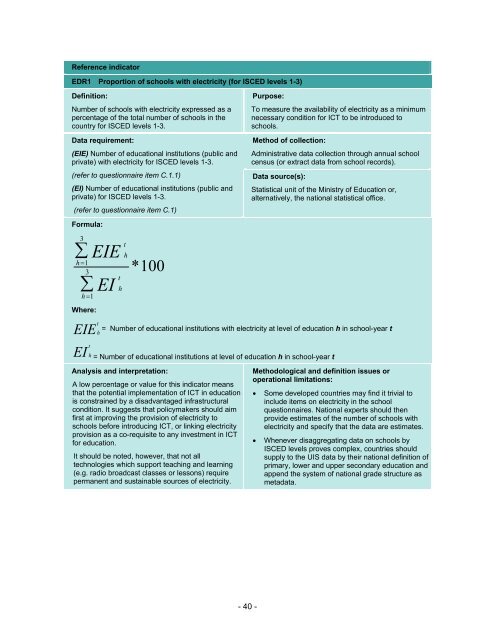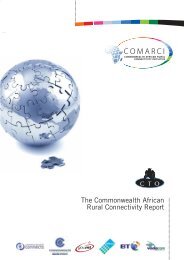Guide to measuring information and ... - unesdoc - Unesco
Guide to measuring information and ... - unesdoc - Unesco
Guide to measuring information and ... - unesdoc - Unesco
You also want an ePaper? Increase the reach of your titles
YUMPU automatically turns print PDFs into web optimized ePapers that Google loves.
Reference indica<strong>to</strong>r<br />
EDR1 Proportion of schools with electricity (for ISCED levels 1-3)<br />
Definition:<br />
Number of schools with electricity expressed as a<br />
percentage of the <strong>to</strong>tal number of schools in the<br />
country for ISCED levels 1-3.<br />
Data requirement:<br />
(EIE) Number of educational institutions (public <strong>and</strong><br />
private) with electricity for ISCED levels 1-3.<br />
(refer <strong>to</strong> questionnaire item C.1.1)<br />
(EI) Number of educational institutions (public <strong>and</strong><br />
private) for ISCED levels 1-3.<br />
(refer <strong>to</strong> questionnaire item C.1)<br />
Formula:<br />
3<br />
<br />
h 1<br />
3<br />
<br />
h 1<br />
Where:<br />
EIE<br />
EI<br />
t<br />
h<br />
t<br />
h<br />
* 100<br />
- 40 -<br />
Purpose:<br />
To measure the availability of electricity as a minimum<br />
necessary condition for ICT <strong>to</strong> be introduced <strong>to</strong><br />
schools.<br />
Method of collection:<br />
Administrative data collection through annual school<br />
census (or extract data from school records).<br />
Data source(s):<br />
Statistical unit of the Ministry of Education or,<br />
alternatively, the national statistical office.<br />
EIE t<br />
= Number of educational institutions with electricity at level of education h in school-year t<br />
h<br />
EI t<br />
h = Number of educational institutions at level of education h in school-year t<br />
Analysis <strong>and</strong> interpretation:<br />
A low percentage or value for this indica<strong>to</strong>r means<br />
that the potential implementation of ICT in education<br />
is constrained by a disadvantaged infrastructural<br />
condition. It suggests that policymakers should aim<br />
first at improving the provision of electricity <strong>to</strong><br />
schools before introducing ICT, or linking electricity<br />
provision as a co-requisite <strong>to</strong> any investment in ICT<br />
for education.<br />
It should be noted, however, that not all<br />
technologies which support teaching <strong>and</strong> learning<br />
(e.g. radio broadcast classes or lessons) require<br />
permanent <strong>and</strong> sustainable sources of electricity.<br />
Methodological <strong>and</strong> definition issues or<br />
operational limitations:<br />
Some developed countries may find it trivial <strong>to</strong><br />
include items on electricity in the school<br />
questionnaires. National experts should then<br />
provide estimates of the number of schools with<br />
electricity <strong>and</strong> specify that the data are estimates.<br />
Whenever disaggregating data on schools by<br />
ISCED levels proves complex, countries should<br />
supply <strong>to</strong> the UIS data by their national definition of<br />
primary, lower <strong>and</strong> upper secondary education <strong>and</strong><br />
append the system of national grade structure as<br />
metadata.
















